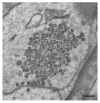Synaptic Vesicle Clusters at Synapses: A Distinct Liquid Phase?
- PMID: 28279363
- PMCID: PMC5347463
- DOI: 10.1016/j.neuron.2017.02.013
Synaptic Vesicle Clusters at Synapses: A Distinct Liquid Phase?
Abstract
Phase separation in the cytoplasm is emerging as a major principle in intracellular organization. In this process, sets of macromolecules assemble themselves into liquid compartments that are distinct from the surrounding medium but are not delimited by membrane boundaries. Here, we discuss how phase separation, in which a component of one of the two phases is vesicles rather than macromolecules, could underlie the formation of synaptic vesicle (SV) clusters in proximity to presynaptic sites. The organization of SVs into a liquid phase could explain how SVs remain tightly clustered without being stably bound to a scaffold so that they can be efficiently recruited to release site by active zone components.
Keywords: exocytosis; intrinsically disordered region; liquid phase; phase separation; synapse; synapsin 1; synaptic vesicle clusters; synaptic vesicles.
Copyright © 2017 Elsevier Inc. All rights reserved.
Figures




References
Publication types
MeSH terms
Substances
Grants and funding
LinkOut - more resources
Full Text Sources
Other Literature Sources

